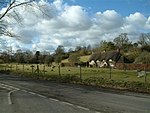The West Kennet Long Barrow, also known as South Long Barrow, is a chambered long barrow near the village of Avebury in the south-western English county of Wiltshire. Probably constructed in the thirty-seventh century BC, during Britain's Early Neolithic period, today it survives in a partially reconstructed state.
Archaeologists have established that the monument was built by pastoralist communities shortly after the introduction of agriculture to Britain from continental Europe. Although representing part of an architectural tradition of long barrow building that was widespread across Neolithic Europe, the West Kennet Long Barrow belongs to a localised regional variant of barrows in Western Britain, now known as the Cotswold-Severn Group. Of these, it is part of a cluster of around thirty centred on Avebury in the uplands of northern Wiltshire.
Built out of earth, local sarsen megaliths, and oolitic limestone imported from the Cotswolds, the long barrow consisted of a sub-rectangular earthen tumulus enclosed by kerb-stones. Its precise date of construction is not known. Human bones were placed within the chamber, probably between 3670 and 3635 BC, representing a mixture of men, women, children and adults. There is then an apparent hiatus in the use of the site as a place of burial, probably lasting over a century. Between 3620 and 3240 BC it likely began to be re-used as a burial space, receiving both human and animal remains over a period of several centuries. Various flint tools and ceramic sherds were also placed within it during this time. In the Late Neolithic, the entrance to the long barrow was blocked up with the addition of large sarsen boulders. During the Later Neolithic and Early Bronze Age, the landscape around West Kennet Long Barrow was subject to the widespread construction of ceremonial monuments, among them the Avebury henge and stone circles, the West Kennet Avenue, The Sanctuary, and Silbury Hill.
During the Romano-British period, a small coin hoard was buried in the side of the long barrow. The ruin attracted the interest of antiquarians in the 17th century, while archaeological excavation took place in 1859 and again in 1955–56, after which it underwent reconstruction. Now a scheduled monument under the guardianship of English Heritage, it is classified as part of the "Stonehenge, Avebury and Associated Sites" UNESCO World Heritage Site and is open without charge to visitors all year round.












